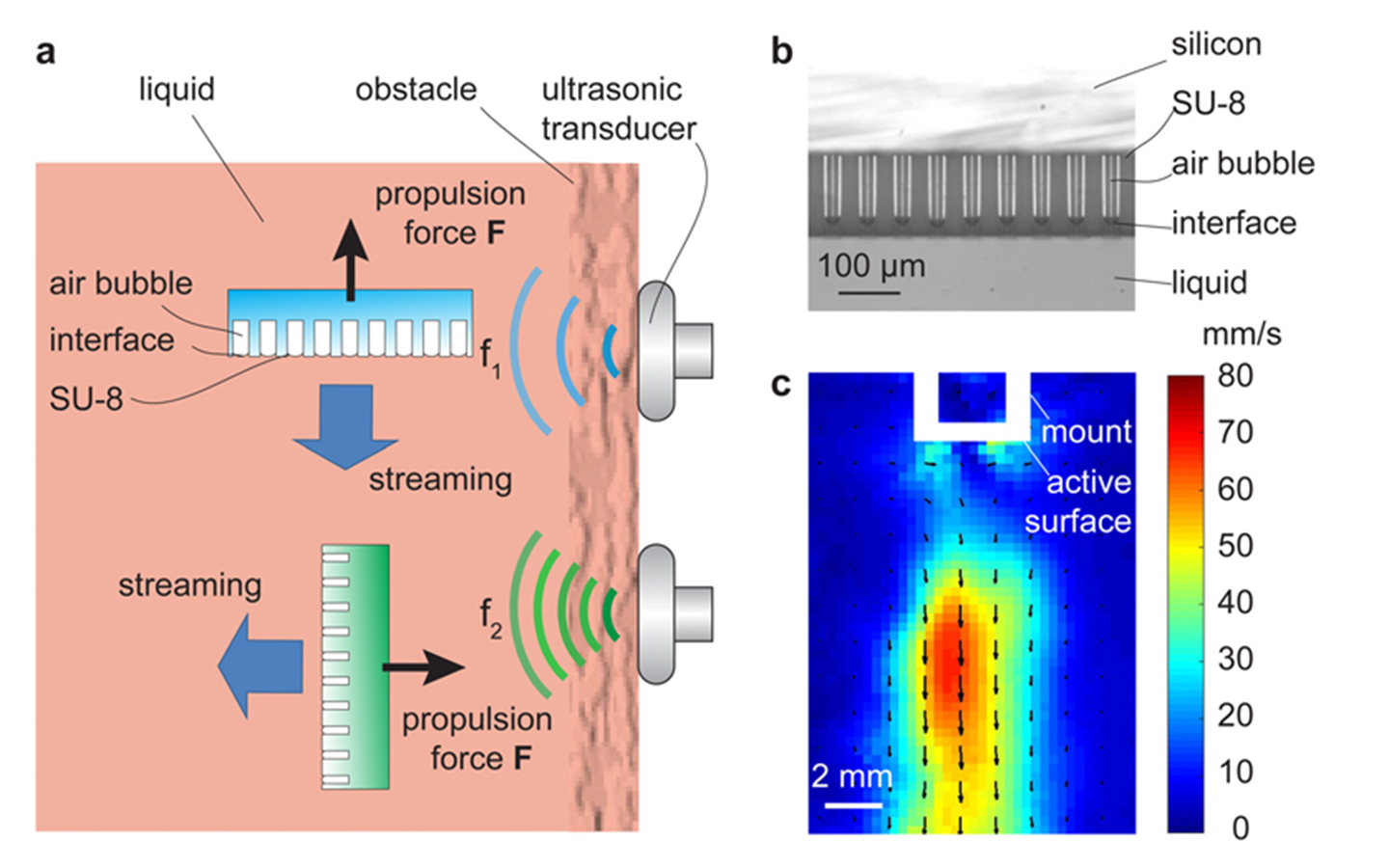Wireless actuation with functional acoustic surfaces

Miniaturization calls for micro-actuators that can be powered wirelessly and addressed individually. Here, we develop functional surfaces consisting of arrays of acoustically resonant microcavities, and we demonstrate their application as two-dimensional wireless actuators. When remotely powered by an acoustic field, the surfaces provide highly directional propulsive forces in fluids through acoustic streaming. A maximal force of similar to 0.45mN is measured on a 4 x 4 mm(2) functional surface. The response of the surfaces with bubbles of different sizes is characterized experimentally. This shows a marked peak around the micro-bubbles' resonance frequency, as estimated by both an analytical model and numerical simulations. The strong frequency dependence can be exploited to address different surfaces with different acoustic frequencies, thus achieving wireless actuation with multiple degrees of freedom. The use of the functional surfaces as wireless ready-to-attach actuators is demonstrated by implementing a wireless and bidirectional miniaturized rotary motor, which is 2.6 x 2.6 x 5 mm(3) in size and generates a stall torque of similar to 0.5 mN.mm. The adoption of micro-structured surfaces as wireless actuators opens new possibilities in the development of miniaturized devices and tools for fluidic environments that are accessible by low intensity ultrasound fields.
| Author(s): | Qiu, T. and Palagi, S. and Mark, A. G. and Melde, K. and Adams, F. and Fischer, P. |
| Journal: | Appl. Phys. Lett. |
| Volume: | 109 |
| Number (issue): | 19 |
| Pages: | 191602 |
| Year: | 2016 |
| Month: | November |
| Day: | 5 |
| Project(s): | |
| Bibtex Type: | Article (article) |
| DOI: | 10.1063/1.4967194 |
| State: | Published |
| URL: | http://aip.scitation.org/doi/abs/10.1063/1.4967194 |
| Electronic Archiving: | grant_archive |
| Note: | APL Editor’s pick. APL News. |
BibTex
@article{2016qiu,
title = {Wireless actuation with functional acoustic surfaces},
journal = {Appl. Phys. Lett.},
abstract = {Miniaturization calls for micro-actuators that can be powered wirelessly and addressed individually. Here, we develop functional surfaces consisting of arrays of acoustically resonant microcavities, and we demonstrate their application as two-dimensional wireless actuators. When remotely powered by an acoustic field, the surfaces provide highly directional propulsive forces in fluids through acoustic streaming. A maximal force of similar to 0.45mN is measured on a 4 x 4 mm(2) functional surface. The response of the surfaces with bubbles of different sizes is characterized experimentally. This shows a marked peak around the micro-bubbles' resonance frequency, as estimated by both an analytical model and numerical simulations. The strong frequency dependence can be exploited to address different surfaces with different acoustic frequencies, thus achieving wireless actuation with multiple degrees of freedom. The use of the functional surfaces as wireless ready-to-attach actuators is demonstrated by implementing a wireless and bidirectional miniaturized rotary motor, which is 2.6 x 2.6 x 5 mm(3) in size and generates a stall torque of similar to 0.5 mN.mm. The adoption of micro-structured surfaces as wireless actuators opens new possibilities in the development of miniaturized devices and tools for fluidic environments that are accessible by low intensity ultrasound fields.},
volume = {109},
number = {19},
pages = {191602},
month = nov,
year = {2016},
note = {APL Editor's pick. APL News.},
slug = {isi-000387999600009},
author = {Qiu, T. and Palagi, S. and Mark, A. G. and Melde, K. and Adams, F. and Fischer, P.},
url = {http://aip.scitation.org/doi/abs/10.1063/1.4967194},
month_numeric = {11}
}





